Interview: Director Elisabeth Tsubota on the World Premiere of LIVE AT THE PURPLE LOUNGE
by Crimson Square Theatre Company in Residence at The Beverly Hills Playhouse
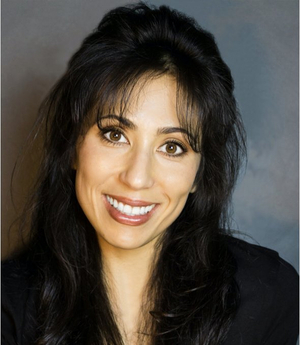
Crimson Square Theatre Company is presenting the world premiere of Live at the Purple Lounge, a drama by five talented female playwrights featuring a cast of five women (plus a few men) involved at a stand-up comedy club. I decided to speak with playwright/director Elisabeth Tsubota (pictured) about her experience working with the all-female writing team and almost exclusively female cast to bring the production to the stage.
Thank you for speaking with me about Live at The Purple Lounge. What would you like readers to know about the play?
Hi Shari, and thank you for taking an interest in our show! Live at The Purple Lounge is an original work generated by Crimson Square's Writer Lab and the theatre company's first world premiere. The play is a dramedy that pulls back the curtain on the lives of five female stand-up comedians in varying stages of their careers. In the green room of the infamous "Purple Lounge" comedy club, relationships are tested, love is lost and found, and sacrifices are made as the play examines the humorous and not-so-humorous moments of five extraordinary women trying to make it in the cutthroat world of stand-up comedy.
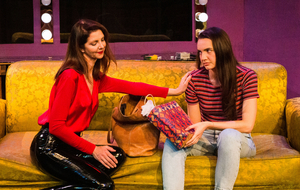
Pictured: Mia Christou, Isabella Olivas
Since the play was written by five female playwrights, including yourself, was the decision to center the play on five female stand-up comedians meant to reflect each of the writers personally?
Yes, and no. What was most important to us was that each scene showcased the writer's unique voice and distinctive talents. Before assigning scenes, we examined each woman's individual strengths, quirks, point of view-basically anything that would help craft the most compelling vignette told as only she could. We considered personal backgrounds, and everyone brought their own experience of themes such as motherhood, addiction, loss, and partnership to the writing in order to present something truthful and relatable. While none of us have worked professionally as stand-ups, the show focuses on each performer's life behind the scenes and the particular struggles that artists and creatives face. These struggles resonated deeply with all five of us, though we all interpreted and presented them differently.

Pictured: Maria Proios, Cameron Meyer
Are you and/or the other writers the creators of the Crimson Square Theatre Company which is presenting the play?
Our show's producer, the wonderful Faye Viviana, created Crimson Square in 2019 as the theatre company in residence at the Beverly Hills Playhouse, with the mission of providing performance opportunities for some of their emerging artists and professionals to share the stage in an ongoing theatre season. In 2020, she expanded the initiative to include a writer's lab and mentorship program to help new writers develop their voices and learn the many aspects of stagecraft. The goal was to create a program that would be the origin story for many great artists of the next generation.
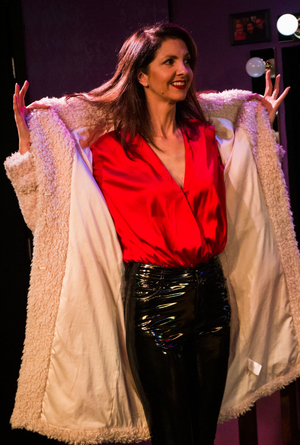 Since all five of the female playwrights (Caroline Patz, Kari Pickering, Rachel Drayke, Elisabeth Tsubota, and Faye Viviana) are from the Crimson Square Theatre Company, is that where the spark was ignited to create Live at the Purple Lounge? (Pictured: Mia Christou)
Since all five of the female playwrights (Caroline Patz, Kari Pickering, Rachel Drayke, Elisabeth Tsubota, and Faye Viviana) are from the Crimson Square Theatre Company, is that where the spark was ignited to create Live at the Purple Lounge? (Pictured: Mia Christou)
Caroline, Kari, Rachel, and Faye were part of the original writer's lab and met every week for almost two years before the play began development. I worked on a film with Faye about a year ago and remember being so impressed when she told me about this group of extraordinary women committing to their weekly meetings throughout the pandemic! I was living outside of LA at the time but told her I would love to get involved, and so we began talks about potentially developing a play that I would come out to direct. By autumn of 2021, we had our concept and set the goal to premiere in the spring of 2022.
What can you share about working with five different female writers for the development process of an original piece, made up for five separate scenes? What was easy to accomplish and what was the most difficult aspect of creating the play together?
I've always loved the development process, and this project was no exception! We had our share of challenges and setbacks, but our collective trust in and respect for one another helped us weather any storm. The easiest part to accomplish was coming up with the initial scenes and workshopping our first drafts. We did this all remotely during scheduled meetings where we would share new pages and give notes. I didn't meet Caroline, Kari, and Rachel in person until we were three months into development!
The most difficult aspect of working with five different writers was making the play one cohesive piece, where every scene served the entire play, not just itself. As writers, we can have such specific ideas of how something should sound that we sometimes lose perspective and don't realize when a part isn't working. We all had to make small concessions and kill some darlings, but in the end, I am incredibly proud of the work each writer did and what we created.
As a first-time director with an all-female writing/producing/directing team as well as the mostly female cast, what are some of the most notable takeaways you can share about working with all that feminine energy during the process?
It was truly wonderful. That being said, I don't want to make generalizations about gender and am aware that it is a very complex and nuanced conversation. Anything I say is based solely on my personal experience working on this production with this particular group of women. There was an incredible atmosphere of support and encouragement during the development and writing process. The writers had the shared goal of originating a piece that examined the complexities of being a woman-particularly a woman in the arts. We helped each other pinpoint exactly what we wanted to say, shared anecdotes from our own lives, and maintained an open and honest environment that valued patience and empathy. During rehearsals, it was incredibly validating to hear so many of the female cast members tell me how the script resonated with their experiences as a woman. In turn, this fostered a creative and safe space for us to explore and experiment throughout the process.

Pictured: Maria Proios, Jeffrey Sun, Diana Murphy
It sounds like a wonderfully creative and artistically rewarding experience! You spoke a bit about why you decided to divide the play into five different scenes so each writer could create a portion of the play in her own style. Is each scene about a single character or do all the five stand-up comedians meet during various scenes?
The decision to divide the play into five different scenes was dually for creative and practical reasons. We wanted to give each writer a slice of the play that was entirely hers, where she could showcase her voice and create a complete story. This was also the most practical way to write as we were unable to meet in person, it was more effective to have each of us work on a large portion of the piece instead of collaborating on every scene together. Each scene examines the life of an individual comic, and the five stand-ups never actually interact with each other, but there is evidence of each of them hidden in the dialogue and set-Easter eggs for the audience. However, the character of Bethany, the Purple Lounge's stage manager (played by Maria Proios), appears throughout the entire play, tethering the scenes to the same reality.
Are any of the female cast members - Maria Proios (Bethany), Diana Murphy (Sydney), Phoebe Pearl (Lena), Cameron Meyer (Abbie), Allison Carmen Cervantes (Anna), Laura Diamond (Logan), Isabella Olivas (Rory) and Mia Christou (Victoria) - stand-up comedians in real life? If not, did you attend any local stand-up shows with them during the creation process? And are any of them Crimson Square Theatre Company students?
Other than Carolyn Kennedy, our understudy who will have select performances as Victoria, none of the cast members are stand-up comedians in real life- though they all have extensive experience acting in comedies. However, we did want to make sure we honored the reality of life as a stand-up, so we consulted with friends and colleagues who are part of that world. We had comics read the script and offer their insights and suggestions, which were invaluable.
I would have loved for us to have attended local stand-up shows together! Unfortunately, with such a big cast and the limitations of Covid, we were unable to do those kinds of comradery building/research activities for this production. Instead, everyone was encouraged to go out and see shows on their own or scour streaming services to help understand and create the world of the play. At times I sent out clips of comedians to cast members, but only for inspiration, as I wanted each character to come to life through the unique talents of the individual actor, not be a replica or imitation of someone else.
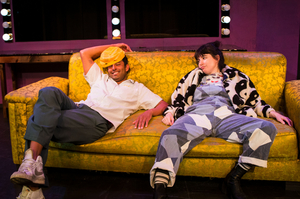
Pictured: James Fahselt, Phoebe Pearl
There are two male characters in the play Jeffrey Sun (John) and James Fahselt (Travis). What roles do they portray? Do they interact with all five stand-ups in each of the scenes?
Jeffrey plays John, the longtime husband of Sydney (played by Diana Murphy), grappling with his wife's newfound desire to perform. James plays Travis, the former writing partner of Lena (played by Phoebe Pearl) suddenly reappearing in her life after a year of estrangement. Both John and Travis only appear in one scene, acting opposite Sydney and Lena. Jeffrey and James did an amazing job of creating dynamic and multi-dimensional characters who are intrinsic parts of the play despite their limited stage time!
Are the two of them the only men involved in the production, either in the cast or on the production/technical team?
Allen Barton, the owner and CEO of The Beverly Hills Playhouse, provided incredible support and mentorship for the production. As an established playwright and director, he contributed crucial insights that helped us troubleshoot any unfamiliar issues destined to arise during the development and production of a new work. Allen gave each writer notes on their pieces but was always respectful and careful not to overstep. Everything was offered as a suggestion, allowing all final decisions to be made by the writer. As a first-time director, I was so grateful he made the time to watch a couple runs of the show throughout the rehearsal process and share his thoughts. In addition to Jeffrey and James, Miles Logan Cooper was added to the cast and will have selected performances as Travis.
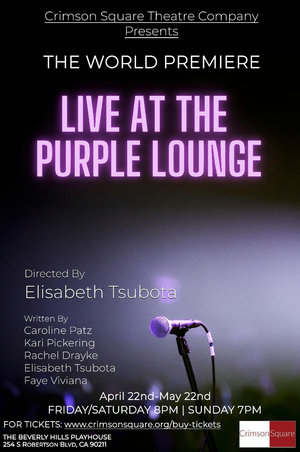 Is there anything else you would like to share about the show and your experience in creating the production?
Is there anything else you would like to share about the show and your experience in creating the production?
I have so much gratitude for the entire cast and crew and cannot wait to share Live at the Purple Lounge with the world! From day one, the writers have worked tirelessly, through countless edits to create a piece that the actors bring to life beautifully. I've loved working alongside Faye, and her dedication to Crimson Square is truly inspiring. Thank you so much for highlighting our production!
Live at the Purple Lounge opens Friday, April 22 at 8pm at the Beverly Hills Playhouse, located at 254 S. Robertson Blvd, in Beverly Hills, CA 90211, running through May 22, 2022 with performances on Friday & Saturday at 8:00PM and Sunday at 7:00PM. More information and tickets at www.CrimsonSquare.org
All cast photos courtesy of Elisabeth Tsubota
Comments

Videos

